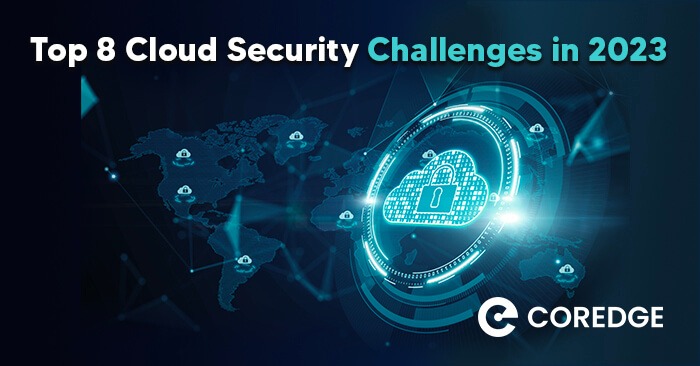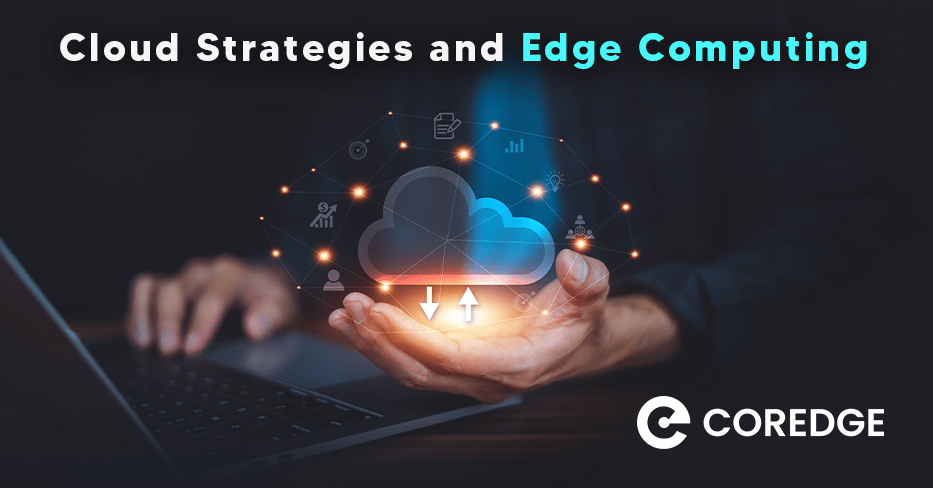Top 8 Cloud Security Challenges in 2023
Coredge Marketing
November 11, 2022

Cloud security is comprised of a set of policies, controls, processes, and technologies that work together to secure and protect cloud-based infrastructure, systems, and data.
These security measures are set up to secure and protect data, support regulatory compliance, safeguard customer privacy, and provide authentication guidelines for individual users. Organizations moving workloads to the cloud must take cloud security into account. Cloud security can be configured to the company’s precise requirements, from validating and authenticating access to filtering traffic. However, cloud security is a complex matter for most companies.
A cloud computing model allocates some of the responsibility of safeguarding sensitive data to third-party providers, but not all of it. Continue reading to find out what cloud security challenges one can anticipate while moving to the cloud and how to deal with them.
8 Cloud Security Challenges to Combat Today:
-
Data Breaches
A data breach is defined as the disclosure of confidential, sensitive, or protected information to an unauthorized individual. It involves unauthorized viewing, sharing, or access to files. Anyone can be at risk of a data breach, from individuals to large enterprises and governments. More significantly, anyone can put others at risk if they are not protected.
Data breaches commonly occur as a result of:
- Technology
- User behavior
IT security professionals control the physical hardware and network infrastructure in on-premises environments. Cloud-based environments are more vulnerable to attacks since some of those controls are delegated to a third-party partner. Hackers can take advantage of vulnerabilities in cloud environments to steal organizations’ private data.
How to manage data breaches in cloud security?
To protect your data, companies should invest in threat prevention tools, tokenization, and data security. Threats can be promptly identified and mitigated using tools like intrusion detection and threat intelligence.
-
Loss of Data:
Many enterprises are unaware of what happens to their data when it is kept in the cloud. When multiple end-users work in the cloud simultaneously, systems are vulnerable to data loss. Thus, the main advantages of sharing and collaboration turn into a pain point for cloud administrators. The main reasons for cloud data loss include unintentional file deletion, password sharing, and the use of personal devices without a password.
Losing cloud data, either through unintended deletion and human negligence, illegal tampering including the installation of malware-i.e. DDoS, or an act of nature that brings down a cloud service provider, could have catastrophic effects on an enterprise. DDoS attack is frequently just a cover for a bigger threat, like an attempt to steal or erase data.
How to handle the loss of data on the cloud?
To prevent hackers from stealing and exploiting critical data, companies must invest in a cloud data loss prevention solution. To stop harmful attacks, one can use dedicated systems, disaster recovery tools, and DLP solutions, protecting the network layer, including the application layer. Connect with our experts to understand how to handle the loss of data on cloud.
-
Internal Threats:
Employees who inadvertently or deliberately endanger the security of an organization are considered insider threats. Typical security lapses caused by personnel include:
- Lack of security knowledge:
Using the same passwords across many accounts and sharing them, as well as using applications without passwords. - Phishing:
A business communication application or a malicious email that deceives recipients into thinking it contains the information they desire or need. The majority of data breaches are caused by phishing scams, as both the victim and the system administrators are often unaware of the attack.
How to manage internal threats on the cloud?
Identity management and automated user access should be combined with regular user education to promote safe, secure, and smart data access practices inside the organization. Do you want to know more? Connect with our experts now!
- Lack of security knowledge:
-
Compliance:
Another significant problem for businesses moving their applications to public clouds is compliance. Although service providers assert that their cloud systems are versatile, the majority of them are unable to achieve the levels of customization that some businesses demand to meet regulatory standards. For instance, HIPAA regulations mandate that only specific types of encryptions be used by healthcare firms to safeguard patient data stored in the cloud.
How to manage compliance issues on the cloud?
A sovereign cloud ensures that all data, including metadata, stays within its borders and, in all circumstances, bans access to data from outside the country. It provides a safe environment for handling and keeping data that is only relevant to one jurisdiction and is never sent across borders. Connect with our professionals to know more.
-
Identity Access Management (IAM):
As many organizations employ hundreds or even thousands of engineers, access should be distributed in accordance with each employee’s role and needs. Modern cloud breaches are largely caused by IAM, and IAM risk goes much beyond just individuals and human access to resources. IAM serves as the network in the cloud, enabling communication between cloud resources.
How to deal with Identity Access Management on the cloud?
Organizations should also implement two-factor authentication, follow rigorous IAM cloud restrictions, rotate their API keys often, and sunset any unused credentials.
-
API Security:
One of the main issues for cloud computing environments is API security. Application programming interfaces (APIs) are a group of definitions and protocols that link various cloud-based applications together. APIs pose a potential security risk to cloud environments because they demand credential authentication and direct access to each app with which they communicate. The danger of security compromise increases along with the variety of APIs.
How to handle API security issues on the cloud?
Use SSL (Secure Socket Layer) encryption to enable secure connections based on factors such as incoming device identification, IP address, and geography.
-
Disaster Recovery (DR)::
An organization’s infrastructure may not be accessible due to calamities like power outages or natural disasters. This situation could last anywhere from a minute to several hours. The most crucial data is out of a company’s control during that time. During the outage, staff members won’t be able to use the systems and tools; furthermore, until access is restored, no data transmission will occur.
What is the solution for disaster recovery on the cloud?
Develop a business continuity and disaster recovery plan that is tailored specifically for cloud workloads and applications. Examine the data security features offered by your cloud provider and seek out regular audit reports. Utilize the disaster recovery as a service (DRaaS) options provided by all significant cloud providers. An organization can also avoid such situations by having a DR copy on the cloud, where data is replicated, and operations can be switched over to maintain the availability of the data. Also, one must ensure that all stored data is always encrypted, and only users should have access to encryption keys.
-
Distributed Denial of Service:
DDoS (distributed denial of service) attacks overwhelm web servers with too much traffic, preventing the server from responding to valid requests.
The DDoS security framework becomes much more complicated to manage due to cloud computing, which is built on shared distributed computing resources and employs a variety of virtualization technologies. A successful DDoS attack can make a website unavailable for several hours or even days. This may lead to a drop in sales, a loss of client trust, and harm to brand credibility.
Large networks of malware-infected systems (computers and internet of things (IoT) devices) under the attacker’s control are typically used in such attacks. A group of such devices is referred to as a “botnet,” and such individual devices are known as “bots” (or “zombies”). Attackers employ these botnets to target servers or networks by concurrently sending requests to the target’s IP address, overburdening the server or network and rendering it inaccessible to regular traffic. Since the bots are legal devices, it might be challenging to distinguish between attackers and legitimate traffic during remediation.
What is the solution for DDoS attacks on web servers?
Investing in DDoS protection services that offer real-time protection against advanced DDoS threats at every network layer, including Layers 3, 4, and 7. Connect with us and book a demo to know how we can help you.
Final Thoughts
Organizations are beginning to understand the advantages of moving to the cloud. Organizations can employ agile systems in cloud environments to gain a competitive edge while lowering their technology costs and operating at scale. Despite the benefits, businesses still need to secure their cloud systems, data, and applications from corruption, deletion, and data leakage.
Organizations are more cautious about migrating business-critical systems to the cloud. They need to know that all essential security provisions are in place. Connect with Coredge experts who can provide end-to-end cloud assistance so that your businesses can operate smoothly. Our team of professionals and our award-winning service have been helping businesses maximize their operations.
Cloud security provides all the perks of traditional IT security and enables organizations to leverage the benefits of cloud computing while remaining safe and secure. Additionally, cloud security ensures that organizations comply with data privacy and compliance requirements. Interested to know more, connect with us to discuss further.





